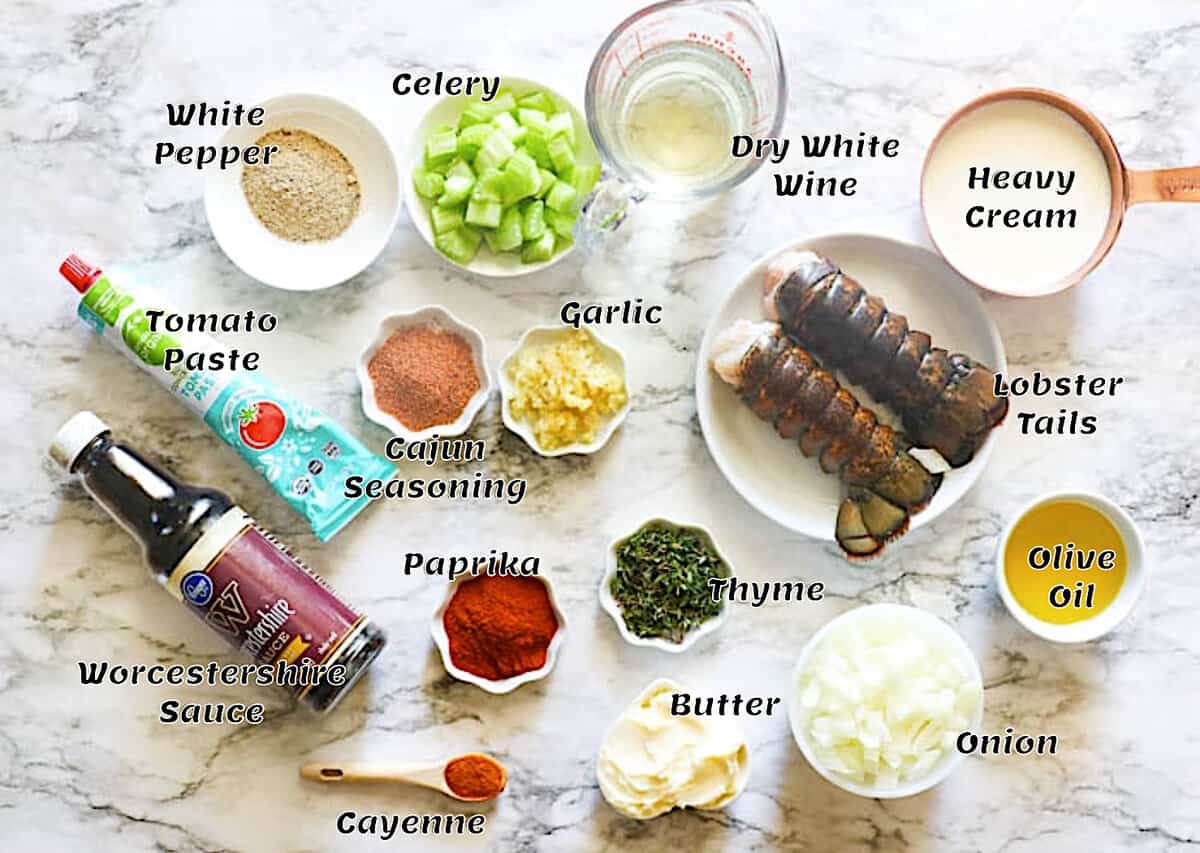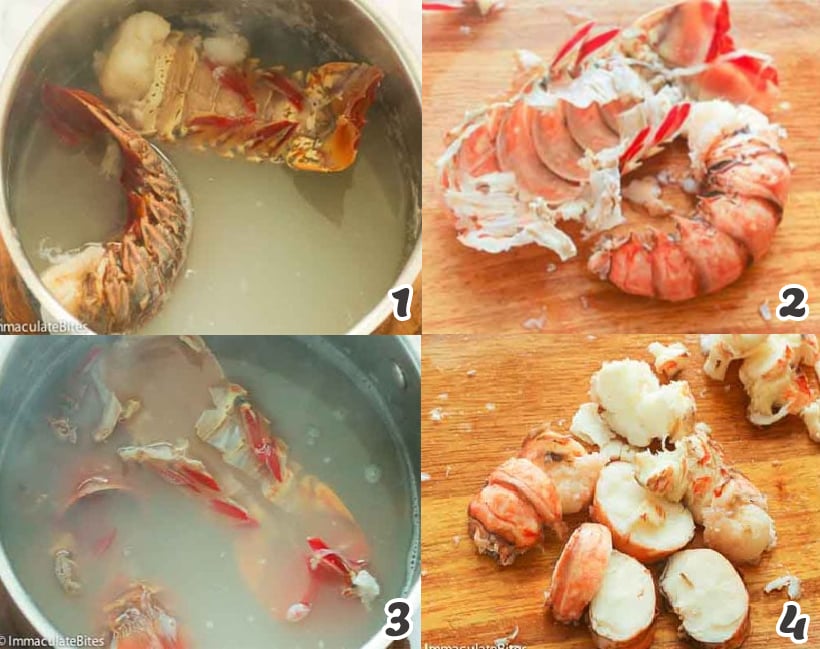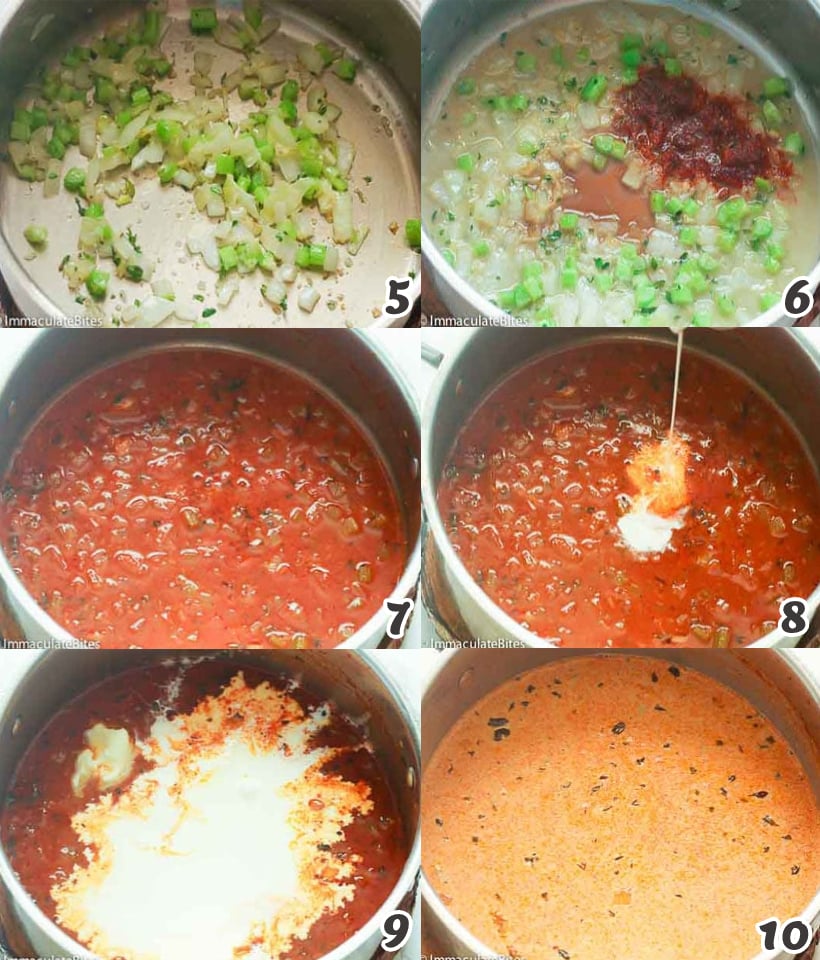Lobster Bisque delivers a creamy, silky-smooth, and well-seasoned soup with lobster and cream. Perfect for your sweetheart on Valentine’s Day, or any day of the year for that matter. Enjoy an indulgent five-star meal at home for a cozy, romantic dinner date.

I love lobster everything: grilled lobster tail, lobster rolls, you name it. And this classic lobster bisque recipe is as good or better than anything you’d get at a fancy-schmancy restaurant. But without the hefty price tag. 😉
And did I mention that this soup is keto-friendly and gluten-free? Woohoo!
Content…What Is It? |

What Is Lobster Bisque?
First off, cream is what makes it a bisque. Pureeing the ingredients to pure silky goodness is also classic for making a traditional bisque. While most bisques boast shrimp or lobster, you don’t have to use crustaceans. You can use tomatoes, butternut squash, mushrooms, and red peppers for an incredible bisque.
However, for lobster bisque, you obviously need lobster. And you don’t waste anything because the shells make a rich seafood broth (think stock but made with the shells instead of beef or chicken bones). So let’s get to the good stuff.
Recipe Ingredients

- Lobster Tails – Fresh or frozen work fine for this recipe. Of course, you can get live lobsters, too.
- Seasonings – Garlic, onion, celery, fresh thyme, and Creole seasoning deliver the ultimate flavor explosion.
- More Flavor – A dry white wine, Worcestershire sauce, lobster stock, and heavy cream make a decadent creamy soup base.
How to Make Lobster Bisque

Prep Lobster and Stock
- Cook Lobster – Boil the lobster tails for 3-4 minutes (long enough for the shells to turn slightly red). Let them cool. (Photo 1)
- Prep Lobster Meat – Place the tails on their side on your work surface and use both hands to press down until the shell cracks. Hold the tail with your thumbs (with the flippers toward you and the shell facing down) on opposite sides. Pull both sides back to crack open the shell and remove the meat.
- Alternative – Cut down the center of the tail with kitchen shears and remove the meat. (Photo 2)
- Make Stock – Return the lobster shells to the pot, and add 4-5 cups water. Bring to a boil, lower heat to medium-low, and simmer for at least 20-25 minutes (if time permits, simmer for an extra 20 minutes). Strain and discard the shells. (Photo 3)
- Chop the Lobster Meat – Chop the lobster meat into bite-sized pieces while the stock is simmering. Chill until ready to use. (Photo 4)

Make the Bisque
- Saute – Heat olive oil in a medium-sized saucepan over medium-high heat. Then saute onion, garlic, celery, and thyme for 4-5 minutes. (Photo 5)
- Flavor – Slowly add the wine, if using, then stir in the Worcestershire, Creole seasoning, paprika, and white pepper. Cook for about a minute. (Photo 6)
- Simmer – Then stir in the tomato paste and 2-2½ cups of the lobster stock. Simmer for 8-10 minutes. (Photo 7)
- Make it Creamy – Pour in the cream and butter, let the butter melt, then remove from stove. (Photos 8-10)
- Puree – Carefully pour it into a blender and puree in batches to avoid pressure building up. Or use a stick blender in the pot until your bisque is smooth.
- Adjust the seasoning with cayenne and salt to taste.
- Assembly – Heat a saucepan over medium and add a tablespoon of butter, followed by the chopped lobster. Then lightly season with Creole seasoning, and simmer for a minute or two until heated.
- Serve – Divide the bisque into serving bowls, top with lobster, and serve immediately.

Recipe Variations
- Seafood – Clams, shrimp, oysters, crayfish, and crab are popular bisque variations. Try my shrimp bisque for a more economical but just as delicious version. 😉
- Vegetarian – Of course, you can make yummy plant-based bisque like my hearty tomato bisque. Squash, corn, potatoes, carrots, and sweet potatoes also make a bisque base.
Tips and Tricks
- You’ll only need 2½ cups of the stock for your bisque, but you don’t need to waste the extra because it freezes well.
- Omit the cayenne if you prefer a milder bisque.
- Lobster tails are usually in the frozen seafood section at most grocery stores. If you go for fresh lobsters, make sure they’re still alive and keep them alive until the last second.
- Swap white wine with brandy for a sweet aroma and subtler presence. Or replace it with stock for alcohol-free bisque.
- Use a fine-mesh strainer to strain the bisque from the blender for a smoother texture.
Serving and Storage Instructions
Lobster Bisque is best as soon as it’s done and still hot. Yum!
I don’t recommend making it ahead since neither lobster nor heavy cream do well in the freezer. But for leftovers, let them completely cool before refrigerating them in an airtight container for up to two days.
Reheat over low heat on the stovetop, covered, occasionally stirring until hot. Or reheat individual servings in the microwave on medium power in 30-second blasts until hot.
What to Serve With Lobster Bisque
Make it a cozy date-night dinner with good background music, good wine, and amazing side dishes. Garlic bread or potato bread rolls, roasted baby carrots, and sauteed Brussels sprouts will definitely impress your better half.
Wine pairing: A chilled Chardonnay or dry Riesling is perfect with lobster bisque.
More Amazing Soup Recipes to Try
Watch How to Make It
[adthrive-in-post-video-player video-id=”QoIpsNAI” upload-date=”2020-12-26T11:52:57.000Z” name=”Lobster Bisque” description=”Lobster Bisque – a classic creamy and smooth, highly seasoned soup made from lobster and aromatics that is a Valentine’s Day favorite entree or served as a first course. A dreamy indulgence of a five-star dining experience – just in time for a cozy date night at home!” player-type=”collapse” override-embed=”false”]
This blog post was first published in February 2018 and has been updated with additional tips, new photos, and a video


Sandra P says
This is insane!!!! Delicious! I love soup and this may be the best I’ve ever had/made. Thank you so much!
ImmaculateBites says
Hi Sandra!
It’s awesome to hear it was one of the best soups you’ve made. There’s something about the richness of lobster bisque that’s just so comforting and decadent.
Enjoy!!!
Camar salem says
I was intimidated with the idea of making this but wow. I was hoping it’d taste like the Whole Foods one but I personally think this was better since it had a little kick. Thanks so much, new go to recipe.
Imma says
I am so glad this was a hit with you, Camar!!
Danny B says
Bonus points for a perfect Friday night dinner for my wife!!! Stock saved to experiment more tomorrow. Perfect recipe and instructions
Imma says
You are more than welcome. And if there’s a recipe you’d love to see, please let me know. Thanks:)
Melanie says
I love this recipe my only question is, do you put all 5 cups of stock in?? Both times I made it it was super thin (still delicious) this time around I’m doing half the stock. Not sure what the correct amount is as it just said add the stock but no amount.
Imma says
Sorry for the confusion. After making your stock, you can freeze the extra or use it in another recipe. You only need 2½ cups of it for the bisque. Hope that helps.
artina sandlin says
21/2 cups lobster stock!
Diana Shope says
do you thaw the lobster tails before cooking them?
Imma says
The consensus is that, yes, you need to thaw frozen lobster tails before cooking. That will ensure it cooks evenly and doesn’t stick to the shell. Please let me know how it goes.
Liraibe says
How do I thicken my soup
Imma says
Usually, the cream makes it thick enough. But if you would like it a little thicker, you can make a flour or cornstarch slurry and slowly pour it in while stirring constantly. Then let it simmer until it thickens, about 3-4 minutes. Since you don’t want your cream to boil, it’s better to do this before you add the dairy. Please let me know how it goes, and thanks for commenting.
George Duncan says
This recipe was great! My wife loved it. We’re looking forward to more recipes. Very easy to follow directions and videos.
ANNETTE VAUGHAN says
I love the recipe, I have a whole batch off prawn shellfish stock on freezer was wondering if that be as good as my lobster is already cooked out of shell, I’m bit nervous about cooking with lobster as I’ve never cooked with it, but I’d really love to use my lobster in a lobster pot pie and thinking off use the bisque as a kinda sauce in the pie , I’d maybe have to thicken it abit , how would you suggest I do that , thanks
ImmaculateBites says
Hmm, what you can do is make a roux to thicken it, and you can reduce the stock by a cup.
Larry Shale says
I followed the recipe to the letter. The one mistake I made was adding a 1/4 teaspoon of cayenne pepper. Made it way to hot. Of course, I still ate all of it. I will definitely make it again without the cayenne. Amazing flavour.
ImmaculateBites says
Hi Larry! Glad that you still loved how it had turned out for you! But I myself, love spicyyy! 🙂
Jenny Fisher says
It was absolutely delicious
I used a Cajun seasoning instead of creole and cayenne and also added the cream after I made the purée
Truly 10/10
Immaculate Bites says
Sooooo good, right? Thank you for giving this recipe a try, Jenny! Don’t forget to make some yummy dessert, too. You can take your pick from my list of 25 Insanely Good Summer Desserts. Enjoy!
Emily says
How much water did you use for the initial boil?
Immaculate Bites says
Hi Emily! Just enough water to cover the lobsters.
Susan says
Delicious
Kymberli Roberts says
We have a storm and I can’t get to the store so I need a last minute fix. Can I make this with imitation crab?
ImmaculateBites says
Yes you can.It might not be as flavorful but it will satisfy your cravings.
Shirleykins says
It was very flavorful. I added a carrot when I simmered them celery. Mine was a little thin. I would make again!
ImmaculateBites says
Thanks for the feedback.